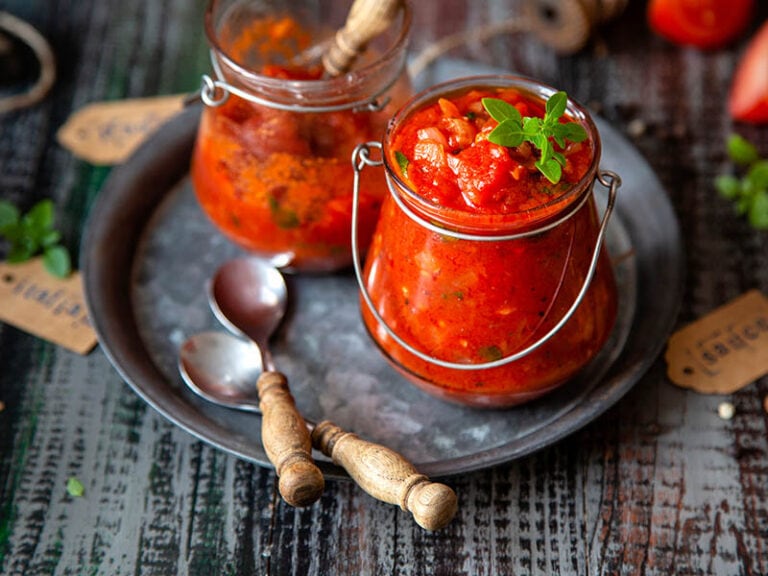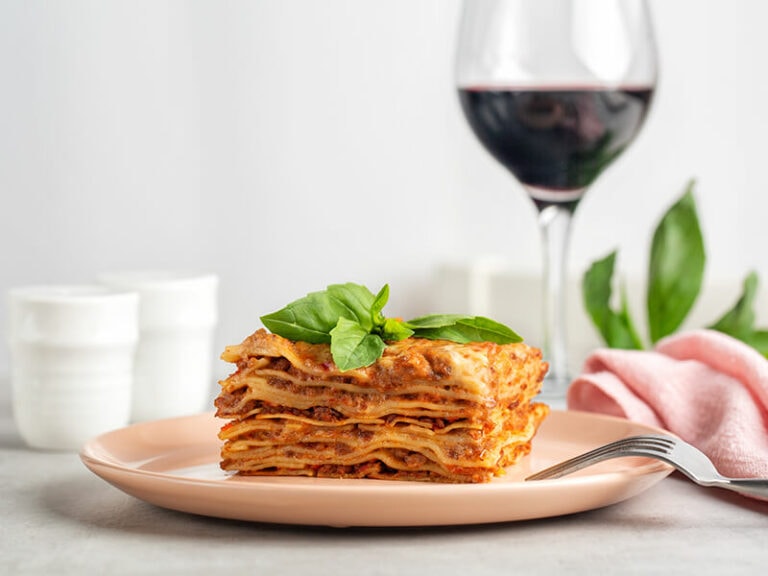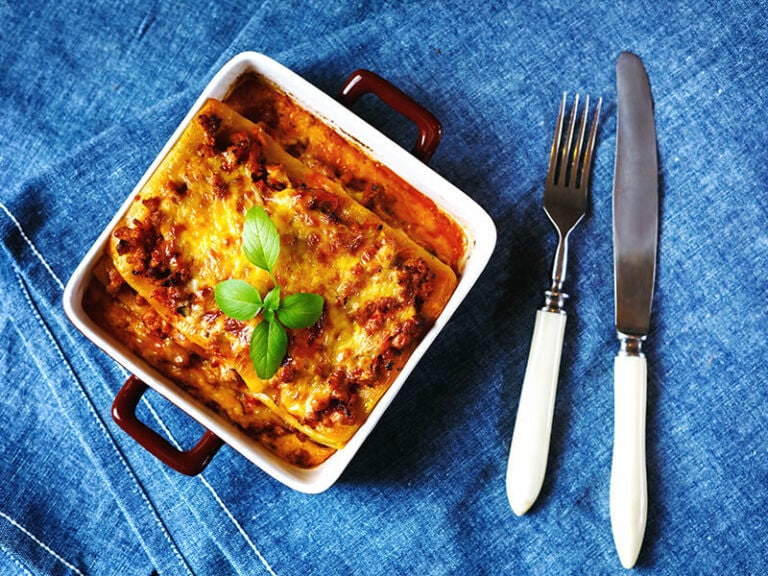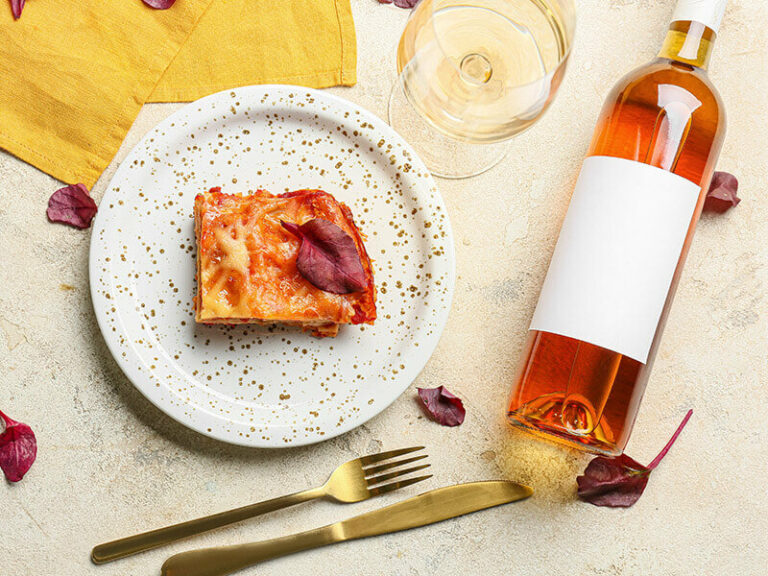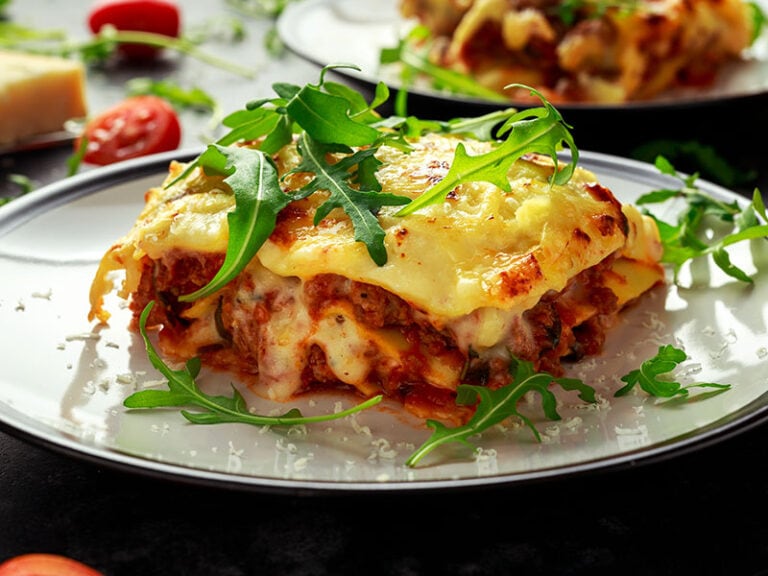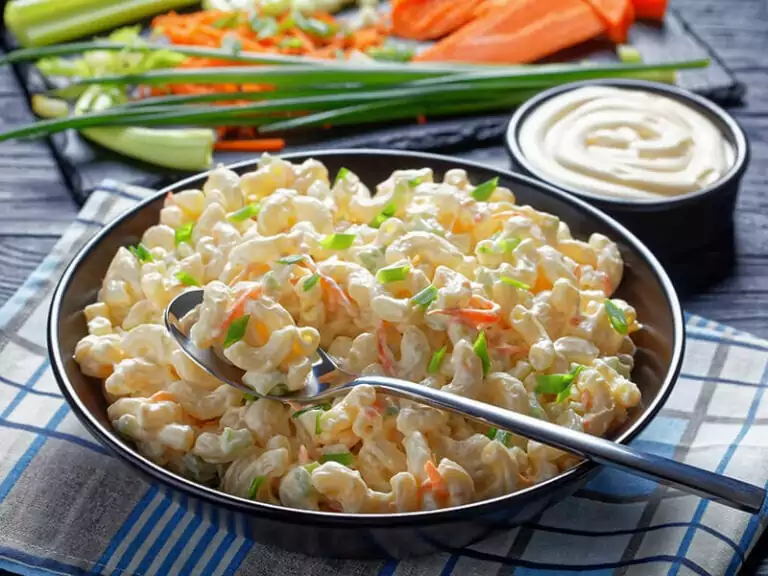Many people are confused when faced with the question: Does pasta have dairy? It is a common question asked by people who are lactose intolerant or don’t like the taste of milk.
The pasta itself does not contain milk. However, the delicious dishes that have the appearance of pasta do. So, sometimes it makes you feel uncomfortable when eating pasta.
Let all the essential information about whether pasta has milk in this article help you. I also provide the issues surrounding it in the most detailed way, so you no longer have to worry about enjoying pasta.
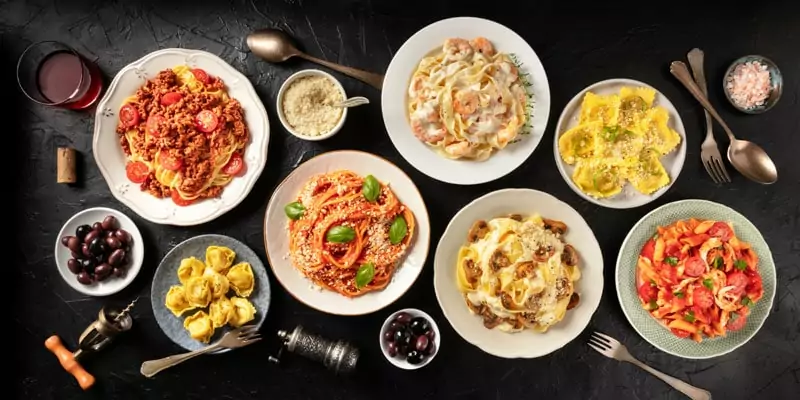
What Is Exactly Pasta?
Pasta is the representative food of Italian cuisine. Usually, people use a mixture of unleavened wheat flour, eggs, olive oil, and water to make it.
After having the desired dough, the pasta is flattened into sheets or other shapes, such as bows or tubes. People cook pasta by either boiling or baking.
Sometimes, rice flour and legumes become substitutes for wheat flour. Obviously, the taste and texture of this pasta type are different, and it’s also gluten-free. You can easily find and buy pasta at stores and supermarkets. (1)
You can easily make pasta at home thanks to this step-by-step instruction.
Is There Dairy In Pasta?
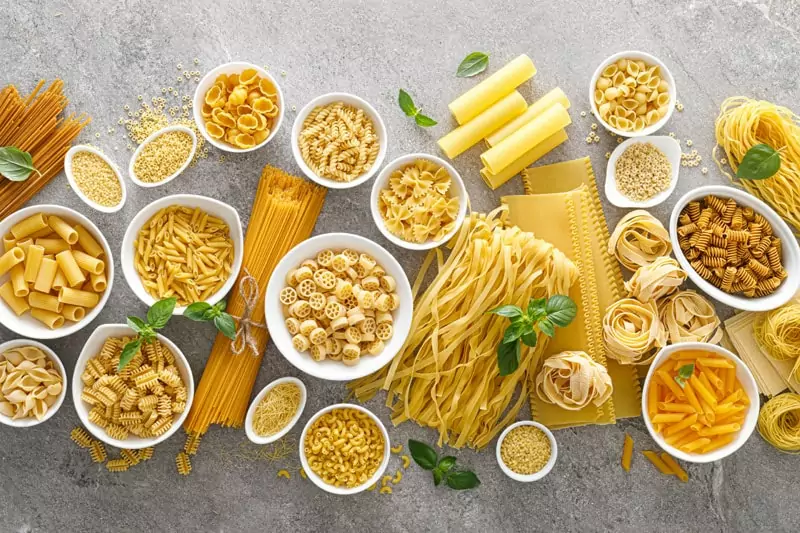
You should always check if the dish contains milk if you are lactose intolerant. Lactose intolerance is a common problem in both adults and children. However, many people overlook this issue.
Lactose intolerance is also known as the malabsorption of sugar from milk. That’s when you eat or drink products that contain milk extracts or milky ingredients but cannot fully digest them.
Common symptoms are bloating, indigestion, and even diarrhea. So, lactose intolerant people often have to avoid milk, cheese, milk-based creams, and butter. (2)
If you are a pasta lover and wonder if it contains milk, the answer is no. As mentioned above, pasta does not contain dairy ingredients. So you can add it to your diet without any worries.
Packaged Pasta & Lactose Intolerance Consideration
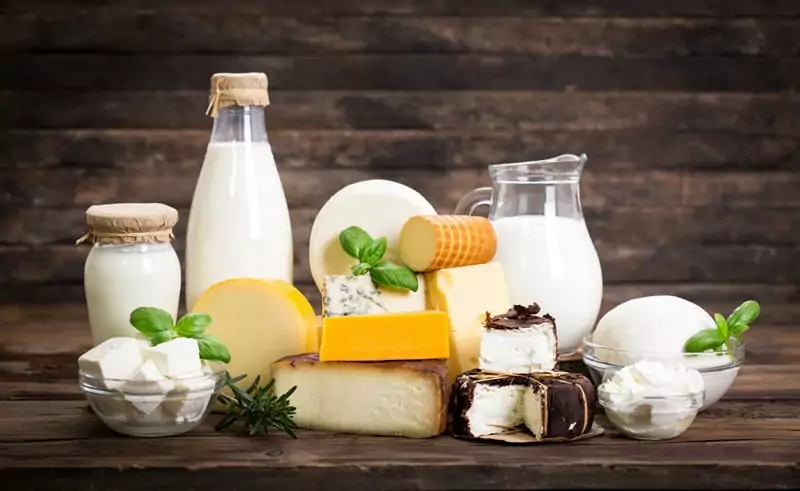
If you use store-bought kinds of pasta, be sure to read the labels printed on them carefully. Because some contain milk and dairy by-products such as cheese and butter.
Usually, the U.S. Food and Drug Administration (FDA) requires all businesses to clearly label common food allergens on product labels, including dairy. Milk, as mentioned, causes lactose intolerance.
Symptoms vary from person to person, depending on the degree of intolerance. It’s still better to go to your doctor for advice if you cannot use milk because of lactose intolerance.
Things To Be Aware Of When Ordering Dairy-Free Pasta
In general, pasta is dairy-free. However, some ingredients or toppings that come with it may contain milk. Below are some common things served with pasta that you should keep in mind if you’re on a dairy-free diet.
The Pasta Sauce
The pasta itself has no dairy ingredients. However, you cannot enjoy pasta without sauce. People make pasta sauce from different ingredients, including butter and milk.
You can either make your own sauce at home to manage its ingredients or ask the server to suggest you a dairy-free sauce. Some canned varieties even have the word “original tomato sauce” on their label, but sometimes contain dairy products.
In addition, a few store-bought pasta brands may add milk to their tomato sauce to enhance the flavor and add a rich and cheesy texture to the products.
The Cheese On Top
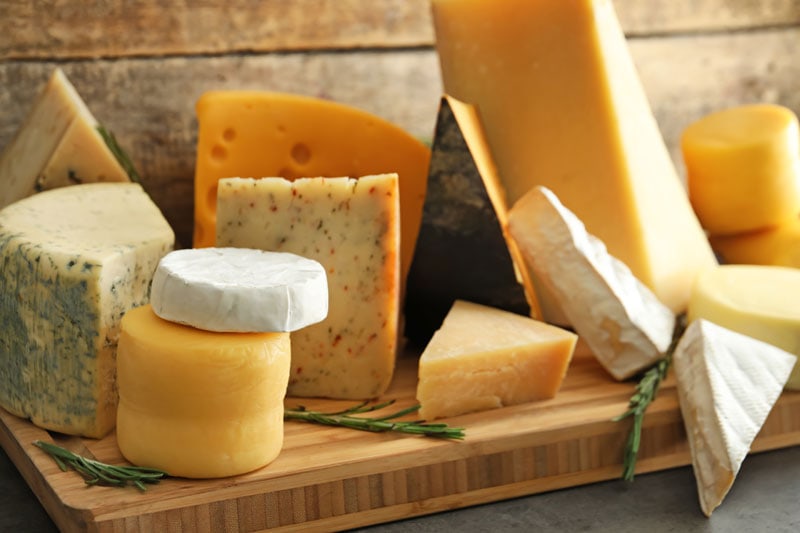
Besides the sauce, people also often serve pasta with cheese. The melted cheese coating on the noodles is always tempting and makes you want to gobble up that dish.
However, cheese usually comes from milk. To avoid using this type, you can ask for no cheese topping or use vegan cheese. Vegan varieties can be made from nuts, oils, soybeans, and especially nutritional yeast.
Nutritional yeast has a salinity and flavor similar to cheese. In addition, it contains nutrients such as minerals and vitamins. This type is considered the best alternative to dairy cheese.
The Pasta Filling
If you love Italian cuisine, you must have tried stuffed noodles. It’s almost like regular pasta but with different fillings inside.
Some popular varieties include Ravioli, Pansotti, Tortellini, and Conchiglie. They might contain dairy ingredients like cheese, cream, sour cream, or milk inside without you even knowing it.
Top 4 Well-Loved Dairy-Free Pasta Sauces
Pasta must always come with a sauce. In the world of cuisine, there are many different types of luscious sauces. Therefore, it is difficult for you to know which sauce has milk or not. Here are the sauces I recommend that are dairy-free.
Marinara
Marinara sauce is a tomato-based sauce. Its main ingredients are tomatoes, herbs, onions, and garlic. Sometimes, people also add olive oil, capers, and spices to enhance the sauce’s flavor.
The marinara sauce comes from Naples and means sailor. You can find it in numerous Italian-American dishes. Marinara goes well with seafood and, of course, pasta.
You can find it in cans at the store or make your own because the recipe is quite simple. Based on the main ingredient, it obviously doesn’t contain dairy.
In less than two minutes, you’ll have a delicious, easy-to-make, dairy-free Marinara sauce.
Aglio E Olio
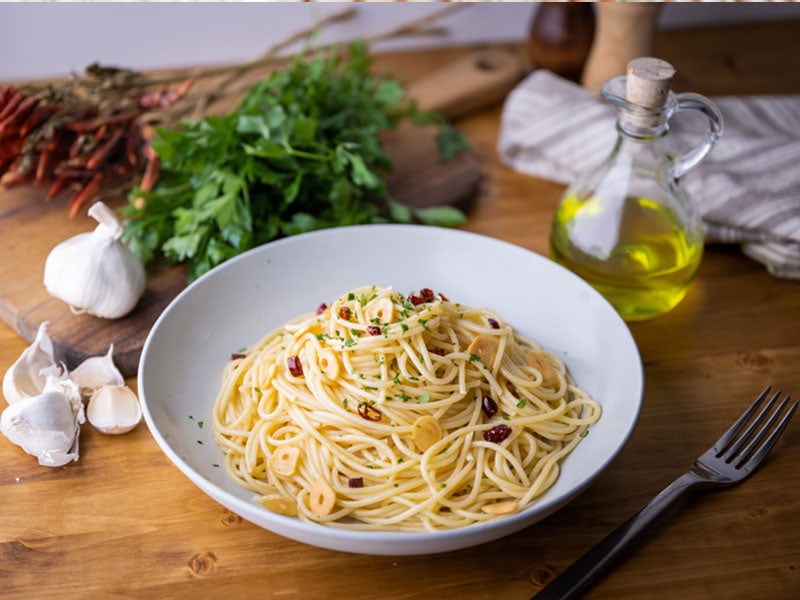
Aglio e olio in Italian means garlic and oil. Indeed, this is a simple Neapolitan sauce and is loved by many people, while its ingredients only have garlic and olive oil.
Perhaps, this sauce’s popularity comes from its ease of preparation, cost-effectiveness, and readily available ingredients. Further, you can store Aglio e Olio sauce for a long time in the pantry. To make this sauce, you just need to stir-fry sliced garlic with olive oil.
When the garlic picks up its signature scent, add optional dried chili. This sauce is perfect for pairing with spaghetti and a little parsley topping.
There are now some variations that include grated parmesan and pecorino cheese. However, do not worry too much as most traditional recipes do not have them.
Bolognese
Bolognese sauce is a basic sauce made from meat and tomatoes.
The name of this sauce comes from its original birthplace – Bologna, Italy. Initially, people enjoyed Bolognese sauce with a type of flat pasta called Fettuccine.
However, with its deliciousness, this sauce extends beyond the province of Bologna and becomes a popular sauce to go with spaghetti. That is also the reason why the phrase “spaghetti bolognese” is popular all over the world.
It is a combination where minced beef, onions, carrots, and celery are slowly cooked until reaching the perfect consistency. The standard Bolognese recipe also includes tomatoes, white wine, and even milk.
However, most of today’s variations do not include milk anymore. You can check with the chef to make sure this sauce is dairy-free.
Check out this bolognese sauce recipe that is full of flavor and dairy-free.
Ragu
Many mistakenly distinguish ragu sauce and Bolognese sauce because both are meat-based and famous sauces in Italian cuisine. The truth is that ragu sauce contains only a small amount of tomato sauce.
Most of its ingredients are from meat such as beef, lamb, veal, pork, poultry, and even fish. Some other chopped foods include carrots, pancetta, and celery. Usually, to make it more intense, people might add a little cream or milk to the ragu sauce.
If you’re on a dairy-free diet, you should check the ingredients in your canned ragu sauce to make sure it is non-dairy.
Some Well-Known Dairy Pasta Sauces
Milk and its products have captivated many diners. Many people prefer to add them to sauces to add a creamy taste to the pasta.
So it’s natural to have a variety of sauces, including milk, cheese, and butter. You can refer to the list to avoid these sauces below.
Alfredo
Alfredo di Lelio, an owner of Via della Scrofa restaurant in Italy, created this famous Alfredo sauce. He had a flash of thought about this sauce in Rome.
According to many, when his wife – Ines, experienced morning sickness and loss of appetite after giving birth, he made Alfredo out of love for his wife.
Initially, this sauce was called fettuccine al triplo burro. It wasn’t until about 1907 or 1908 that it was renamed fettuccine all’Alfredo (or fettuccine Alfredo).
It is also quite simple when you just need to fry the garlic. Then, melt the butter and cream over low heat until the mixture thickens. You may top Alfredo sauce on the pasta with some shredded Parmesan cheese and parsley.
Alfredo pasta quickly became so popular that Mary Pickford and Douglas Fairbanks (American actors and actresses) brought it back to the United States with them.
As you can see, this sauce is famous for its utilization of dairy ingredients. Therefore, people who are lactose intolerant should steer clear of Alfredo sauce.
Carbonara
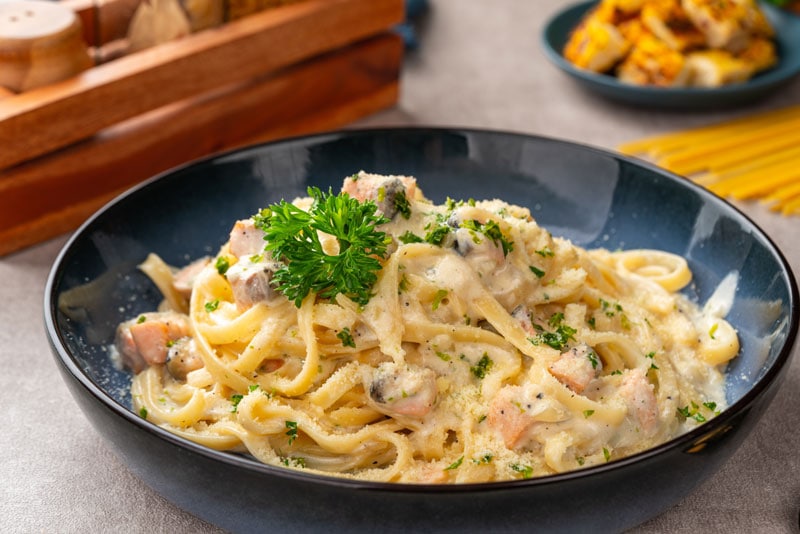
Similar to Alfredo sauce, Carbonara also includes a variety of dairy ingredients. It has a slightly salty, creamy taste from a combination of egg yolks, cheese, full-fat cream, and bacon.
It is made richer with garlic and black pepper. At first glance, the colors of Carbonara and Alfredo are quite similar.
However, thanks to the egg yolk, Carbonara is more golden. It is a creamy sauce that combines all of the above ingredients, and people serve it with spaghetti and other pasta types.
Pesto
The third dairy sauce is Pesto. It is one of the traditional Italian sauces that originated in Genoa. Dating from around the 16th century, pesto consists of crushed garlic, Parmesan cheese, coarse salt, European pine nuts, and basil leaves.
The flavor is characterized by the aroma of basil, the saltiness, and of course, the richness of the cheese. Parmesan is a hard cheese and is made from cow’s milk. Pesto sauce is made by pounding or crushing all the ingredients with a mortar and pestle.
Vegan Vs. Dairy-Free Diet
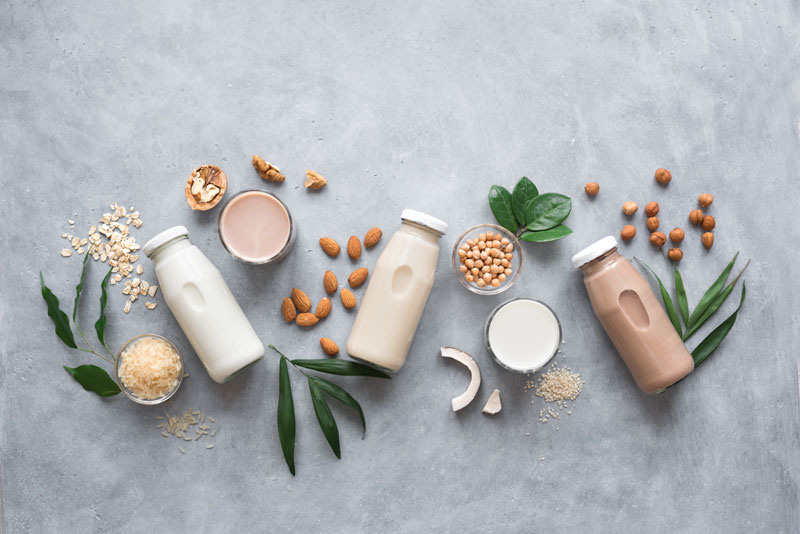
You may be wondering if vegan and dairy-free are the same. They appear to be similar but are actually not.
- A vegan diet only includes plant-based foods (such as vegetables, grains, nuts, and fruits). Vegans abstain from all animal-derived foods, including dairy and eggs.
- Dairy-free diets omit all dairy products, including animal milk, cheese, yogurt, butter, and cream derived from milk. However, persons who follow this diet may still consume animal goods such as meat, fish, and shellfish.
So it can be said that the vegan diet includes no dairy. However, not all dairy-free recipes are vegan. When ordering a dish in a restaurant, you can check whether it’s vegan. If so, then a non-dairy person like you can enjoy it with no worries.
Add a fail-proof vegan pasta sauce recipe to your menu through this detailed guide.
FAQs
As for whether pasta contains milk, there are still many issues to discuss. You can refer to some more frequently asked questions below for more information about it.
Now You Can Safely Include Pasta In Your Diet
Pasta is a familiar and almost everyday dish for many people. So it’s normal for you to wonder whether pasta contains milk.
In fact, the pasta itself does not include dairy at all. However, the dishes that go with it have wide varieties and might contain milk in their ingredients. The fact that you accidentally buy those types is difficult to avoid.
Hopefully, the information that the article provides is enough for you to know more about pasta and the problem with dairy foods. Please share this post with the people you know because it is directly related to their health.
References
- Pasta (2022) Wikipedia. Wikimedia Foundation.
- Lactose intolerance (no date) National Institute of Diabetes and Digestive and Kidney Diseases. U.S. Department of Health and Human Services.

